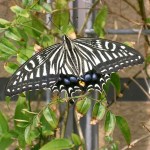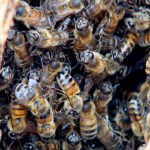Life Science
Image Source: www.animalsandearthquakes.com
The recent earthquake on the East Coast has me thinking about animals. Specifically, animals that can reportedly predict earthquakes...a feat humans have yet to reliably accomplish.
According to the US Geological Survey, animals may be able to sense the fast traveling P waves which arrive seconds prior to the S wave of an earthquake. Although many studies suggest that observing animals in the hopes of being able to predict earthquakes is not a viable option since animals respond to many environmental cues. So how do you know when the strange…
Image Source: NSF.gov
As the heat of summer drags on...and on...I can't help but envy heat tolerant animals. The BBC Worldwide actually has a website dedicated to these thermophiles, or heat loving animals.
I would never have guessed that a worm would be the most heat tolerant animal known. Specifically, the Pompeii worms thrive at temperatures up to 80 degrees C in a hydrogen sulfide-rich environment. You can watch the video called "Deep Surprises" here. Imagine temperatures that hot! These worms would probably need a portable heater to survive the comparatively chilly summer temperatures…
Seals are actually able to reduce the temperature of their brains to decrease the amount of oxygen needed to sustain metabolism during dives. In a recent study, the brains of harp (Pagophilus groenlandicus; shown above) and hooded (Cystophora cristata) seals were found to cool by as much as 2.5°C during dives in 4°C water. This translates into a reduction in brain oxygen consumption of 25%. Temperatures within the aorta were also found to decrease during diving. Studying the vasculature of the front flippers, they discovered that blood could be shunted to large superficial veins allowing…
The winner of our Summer Photo Contest is "Dip in the Pool" (above) submitted by Amanda Byrnes. The photo was taken this summer in Massachusetts. This particular photo was chosen because it exemplifies how frogs, which are ectotherms, can cool off in the heat of the summer. Congratulations Amanda! As the winner, she will receive a fabulous "What's new in comparative physiology" t-shirt from The American Physiological Society!
Honorable Mentions:
There were so many excellent entries that choosing a winner was a very difficult decision. Therefore I would like to share the top choices from our…
Chicks hatch from their eggs with the ability to walk and swim. After only 3 days in the egg, chicks begin to move. Researchers wanted to know if the movements in the egg prepared chicks for their big debut. They synchronized electromyograms for leg muscles, force, and video from late-stage embryos on days 15, 18 and 20 of their incubation. What they discovered was that the repetitive movements of the embryonic chicks were related to locomotion. These findings support the idea that chicks do in fact practice moving while still in the egg!
Click here to watch a fun video of a chick hatching.…
Male:
Female: Images Source: USFWS
Ever wonder how the plumage of birds can be so colorful? Take, for example, the Yellow-headed blackbird (Xanthocephalus xanthocephalus) shown above. Those yellow feathers are possible because of yellow-red dietary pigments called carotenoids. It turns out that these pigments don't just stop at ensuring colorful sexual displays. They are also known to act as antioxidants, immune system stimulants, as well as precursors to vitamin A. Therefore birds with more colorful displays are thought to be healthier than those with dull displays...an important outward…
Once again, NOVA did not disappoint. I really enjoyed watching the "Rat Attack" special. I don't want to spoil it for anyone who has not yet had a chance to watch it, but I found the cyclical correlation between black rat populations and bamboo flowering fascinating. I was astonished to learn how quickly black rats could reportedly reproduce resulting in as many as 10,000 rats per acre. The problem is when the rats run out of bamboo fruits to eat, they turn to crops, causing widespread famine. With the new information presented in the documentary, farmers may be able to help prevent famine…
Once again I find myself looking forward to a special program by NOVA National Geographic called "Rat Attack". The program airs tonight so be sure to check your local PBS listings for times.
Here is a description of the special:
"Once every 48 years, bamboo forests in parts of northeast India go into exuberant flower. Then, like clockwork, the flowering is invariably followed by a plague of black rats that appear to spring from nowhere to spread destruction and famine in their wake. For the first time on film, NOVA and National Geographic capture this rat population explosion in vivid…
What could be more exciting than Shark Week on Discovery Channel? It airs at 9pm Eastern every night this week. You can also see video clips online such as my personal favorite, the top 10 weird sharks.
Be sure to check out the video clip of the frilled shark (above) which was once thought to be extinct. This Loch Ness Monster look-alike has enlarged gills that allow it to swim in the deep sea where oxygen levels are low. You can read more about the anatomy of the frilled shark here.
A reader sent in this intriguing question in response to the previous post on cuttlefish:
"What is there vision like? Do they really see around them clearly enough to have evolved mimicry?"
Researchers Mathger et al. have shown that the animals are actually colorblind but can distinguish objects that contrast from the background environment by as little as 15%. Images from their work are shown below:
Can you find the cuttlefish in these images from the paper?
Cuttlefish also have cells called iridophores and leucophores that reflect the brightness of their environments further helping them…
Photo: KENPEI, Wikimedia Commons.
Researchers have isolated an antimicrobial peptide from swallowtail butterflies, Papilio xuthus (image above). After creating a synthesized version of the peptide they called Papiliocin, they wanted to know how it worked. What they found was that Papiliocin causes yeast cells (Candida albicans) to accumulate reactive oxygen species, which triggers a process called apoptosis, or programmed cell death. To see a neat video describing apoptosis, click here.
Papiliocin is not only an anti-fungal. This versatile peptide is also antibacterial, although researchers…
I watched an amazing Nova special on cuttlefish, a relative of octopus. These animals really are the "Kings of Camouflage!" I have seen animals that can change colors to match their environments, but I have never seen one able to produce moving colors or to contort their bodies to mimic objects in their environment, like seaweed. Even more amazing is that researchers have discovered one species, the flamboyant cuttlefish, that is actually poisonous which explains why they are brave enough to walk around the ocean floor instead of swim like their cousins. Researchers are currently examining…
I was recently sent this intriguing question from a reader:
Dear Dr. Dolittle,
I heard in my science class that because honeybees have such high blood sugar levels, they can survive freezing...is that true?
To answer this question, I turned to expert Dr. John G. Duman from the Department of Biological Sciences at the University of Notre Dame who studies antifreeze proteins in insects. Here is what he had to say:
In short, no.
Insects generally survive subzero environmental temperatures by evolving one of two strategies. Some are freeze tolerant, meaning that they can survive the freezing…
Our summer photo contest is still under way! Please send your favorite photo of how animals are spending the summer to drdlttl01@gmail.com for a chance to win a fabulous "What's new in comparative physiology" t-shirt from The American Physiological Society!
Photo Copyright: Arizona Game and Fish Department
Looking at this photo, I can't help but wonder why a bobcat thought it would be a good idea to climb to the top of a saguaro cactus...a really tall saguaro cactus. I had to find out. I did what anyone would do and searched Google.
I found this video complete with photos describing how the bobcat was being chased by a mountain lion. So it climbed up the 40 foot cactus where it stayed for hours waiting for the mountain lion to give up before it climbed back down.
I think if the bobcat had seen these photos of a mountain lion climbing a 30 foot…
Image Source: The Goldfish Bowl: Canterbury Writers
Gills are to fish what lungs are to mammals. This is where gas exchange between the animal and the environment takes place. As water flows across the gills, oxygen is taken up into the blood of the fish and carbon dioxide is removed. In both systems, oxygen is transported throughout the body by binding to hemoglobin molecules within red blood cells.
Image of goldfish gills from: How to take care of a goldfish: Pet goldfish care guide
Researchers Velislava Tzaneva, Shawn Bailey, and Steve F. Perry from the Department of Biology at the…
Image source: The American Physiological Society.
I just read an amazing review article written by George Somero from the Department of Biology at Stanford University on how the field of comparative physiology may be used as a crystal ball to predict how different species will respond to global changes. Some changes that may impact species include temperature, salinity, pH, and oxygen levels. For these studies, scientists often examine closely related species that are adapted to different environments to see how they differ physiologically and behaviorally.
Changes in biogeographic…
I will be celebrating the 4th of July this weekend with lots of barbecues while enjoying the summer weather. But I wonder what our animal friends will be doing this weekend...
If last year is any indication, we know the animals at the Oregon Zoo will be having a lot of fun! To see just how much, watch this video clip.
This year, the animals at the Georgia Aquarium have a very special way of saying "Happy 4th of July"! You can watch here.
I want to wish you all a very Happy 4th of July as well!
Anyone who has seen the movie March of the Penguins knows that these animal undergo long periods of fasting. There are actually 3 stages of fasting in birds.
Phase I: This is a short phase in which they burn stored fat for energy.
Phase II: In this long phase, animals are constantly losing body mass and trying to spare proteins. Fat continues to be the main source of energy.
Phase III: Animals enter this phase if fat reserves start running low. This is when changes in hormones and metabolism occur resulting in a switch from using fats to using proteins for energy. Along with the…













